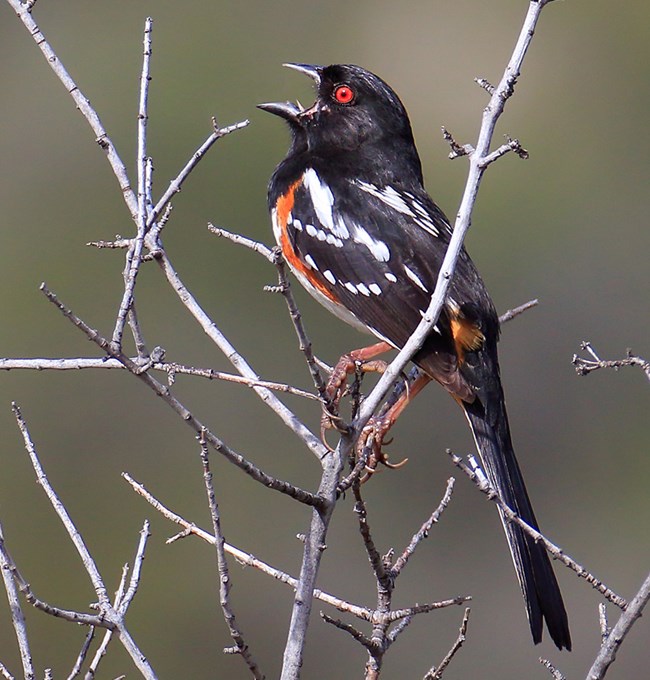Mallard
Hooded Merganser
Common Merganser
Ring-necked Pheasant
Wild Turkey
Mountain Quail
California Quail
Common Loon
Pied-billed Grebe
Western Grebe
American White Pelican
Double-crested Cormorant
Great Blue Heron
Great Egret
Green Heron
Turkey Vulture
California Condor
Osprey
White-tailed Kite
Bald Eagle
Northern Harrier
Sharp-shinned Hawk
Cooper’s Hawk
Red-shouldered Hawk
Rough-legged Hawk
Golden Eagle
American Kestrel
Merlin
Peregrine Falcon
Prairie Falcon
Virginia Rail
American Coot
Killdeer
Spotted Sandpiper
Greater Yellowlegs
Lesser Yellowlegs
Western Sandpiper
Least Sandpiper
Baird's Sandpiper
Common Snipe
Black-legged Kittiwake
Rock Pigeon
Band-tailed Pigeon
White-winged Dove
Mourning Dove
Greater Roadrunner
Barn Owl
Western Screech-Owl
Great Horned Owl
Northern Pygmy-Owl
Burrowing Owl
Long-eared Owl
Northern Saw-whet Owl
Common Poorwill
Black Swift
White-throated Swift
Black-chinned Hummingbird
Anna’s Hummingbird
Costa’s Hummingbird
Calliope Hummingbird
Rufous Hummingbird
Allen’s Hummingbird
Belted Kingfisher
Lewis’ Woodpecker
Acorn Woodpecker
Red-breasted Sapsucker
Nuttall’s Woodpecker
Downy Woodpecker
Hairy Woodpecker
Northern Flicker
Chukar
Pileated Woodpecker
Olive-sided Flycatcher
Western Wood-Pewee
Willow Flycatcher
Hammond's Flycatcher
Pacific-slope Flycatcher
Black Phoebe
Say’s Phoebe
Ash-throated Flycatcher
Western Kingbird
Loggerhead Shrike
Bell’s Vireo
Gray Vireo
Cassin’s Vireo
Hutton’s Vireo
Warbling Vireo
Steller’s Jay
Western Scrub
Jay Clark’s Nutcracker
Yellow-billed Magpie
American Crow
Common Raven
Tree Swallow
Violet-green Swallow
Northern Rough-winged Swallow
Cliff Swallow
Barn Swallow
Chestnut-backed Chickadee
Oak Titmouse
Bushtit
Red-breasted Nuthatch
White-breasted Nuthatch
Pygmy Nuthatch
Brown Creeper
Rock Wren
Canyon Wren
Bewick's Wren
House Wren
Winter Wren
American Dipper
Golden-crowned Kinglet
Ruby-crowned Kinglet
Blue-gray Gnatcatcher
Western Bluebird
Mountain Bluebird
Townsend’s Solitaire
Swainson’s Thrush
Hermit Thrush
American Robin
Varied Thrush
Wrentit
Northern Mockingbird
California Thrasher
European Starling
Cedar Waxwing
Phainopepla
Golden-winged Warbler
Orange-crowned Warbler
Nashville Warbler
Yellow Warbler
Yellow-rumped Warbler
Black-throated Gray Warbler
Townsend's Warbler
Hermit Warbler
American Redstart
Northern Waterthrush
Macgillivray's Warbler
Common Yellowthroat
Hooded Warbler
Wilson's Warbler
Yellow-breasted Chat
Western Tanager
Green-tailed Towhee
Spotted Towhee
California Towhee
Rufous-crowned Sparrow
Chipping Sparrow
Black-chinned Sparrow
Lark Sparrow
Sage Sparrow
Grasshopper Sparrow
Fox Sparrow
Song Sparrow
Lincoln's Sparrow
White-throated Sparrow
White-crowned Sparrow
Golden-crowned Sparrow
Dark-eyed Junco
Black-headed Grosbeak
Lazuli Bunting
Red-winged Blackbird
Western Meadowlark
Brewer's Blackbird
Brown-headed Cowbird
Hooded Oriole
Bullock's Oriole
Purple Finch
Cassin's Finch
House Finch
Pine Siskin
Lesser Goldfinch
Lawrence's Goldfinch
American Goldfinch
Evening Grosbeak
House Sparrow


